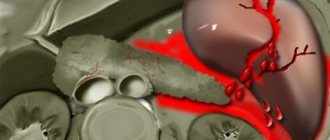How does the disease manifest? Signs of liver problems
- External manifestations
- Internal manifestations
The liver is the largest gland in the human body, so its diseases have a serious impact on overall health. At the same time, it is very sensitive and extremely susceptible to various disorders. Doctors often hear the complaint “I have pain in the liver area.” But can the liver itself hurt and what sensations does a person experience when various diseases appear?
1.Common liver diseases
Liver diseases are a long list of diseases that are studied by a special branch of medicine - hepatology. Even though the liver is the only organ that is capable of complete regeneration, liver disease is very common and serious. Liver diseases can be either hereditary or result from various factors. Liver diseases can also be divided into temporary and chronic.
Here are just a few of the common liver diseases:
- Treatment of diffuse liver diseases;
- Functional hyperbilirubinemia;
- Primary biliary cirrhosis of the liver;
- Primary sclerosing cholangitis;
- Hepatolenticular degeneration;
- Chronic hepatitis;
- Liver tumors;
- Liver abscess;
- Acute hepatitis;
- Cirrhosis of the liver;
- Liver steatosis;
- Hemochromatosis;
- Liver cysts;
- Amyloidosis.
Hepatitis
Hepatitis is a general name for a group of inflammatory liver diseases of various etiologies. There are hepatitis A, B, C, D, E and F. Hepatitis, unlike other diseases, spreads to the entire organ, therefore it is considered especially dangerous.
Cirrhosis of the liver
Liver cirrhosis is a serious disease in which the liver becomes enlarged because... parenchymal tissue is replaced by fibrous tissue. Cirrhosis develops after prolonged alcohol abuse or as a result of viral hepatitis.
Liver cancer
Liver cancer is a malignant tumor in the organ. Typical symptoms of liver cancer:
- Jaundice;
- Heaviness and pain in the right side;
- Nausea and vomiting;
- Fever;
- Hemorrhagic syndrome;
- Ascites;
- Cachexia.
A must read! Help with treatment and hospitalization!
Help the liver with Phosphogliv*
If liver problems are detected, the patient is prescribed diet and exercise; if this is not enough, therapy is supplemented with medications. It often includes the use of hepatoprotectors - drugs for treating the liver. One such drug is Phosphogliv*. Phosphogliv* is used as a means of pathogenetic therapy. This product contains 2 active ingredients: glycyrrhizic acid and essential phospholipids.
Glycyrrhizic acid has anti-inflammatory, antioxidant and antifibrotic effects, which allows the drug to be used both at the stage of treating inflammation and for preventing its development, and essential phospholipids restore damaged liver cell membranes. The use of the drug Phosphogliv* ensures normalization of the patient’s general condition, relief of the inflammatory process in the liver - a decrease in ALT and AST enzymes, and also helps prevent the development of fibrosis and cirrhosis.
3.Risk factors
Risk factors that affect the likelihood of developing liver disease:
- Work in chemical laboratories conducting analyzes of body fluids;
- Increased levels of cholesterol and triglycerides in the blood;
- Work involving chemicals and toxins;
- Some medicines;
- Alcohol abuse;
- Piercing and tattoos;
- Blood transfusion;
- Unsafe sex;
- Obesity;
- Diabetes.
About our clinic Chistye Prudy metro station Medintercom page!
What functions does the liver perform?
A normally functioning liver of a healthy person performs many vital functions:
- neutralizes poisons, toxic metabolic products, etc., converting them into harmless or quickly eliminated compounds from the body;
- breaks down and ensures removal from the body of spent biologically active substances (hormones, neurotransmitters, vitamins, etc.);
- during gluconeogenesis, converts fatty acids, amino acids, glycerol and other substances into glucose as an energy source;
- accumulates glycogen (a substance that can quickly turn into glucose when it is greatly reduced in the blood);
- participates in the formation and metabolism of vitamins;
- participates in the regulation of fat metabolism;
- produces enzymes, bile acids and bilirubin necessary for digesting food and neutralizing toxic substances.
- plays the role of a depot for blood volume (in case of large blood losses, this blood returns to the bloodstream, thereby preventing oxygen starvation of tissues).
Theoretically, any of these functions will be impaired for one reason or another and such a condition will be called liver dysfunction. Most often, liver function is disrupted as a result of poisoning, alcohol abuse, heavy food, etc. The condition of other organs and systems of the body also plays an important role.
4. Diagnosis and treatment of liver diseases
Diagnosis of liver diseases
To diagnose liver diseases, the first step is to consult a general practitioner. He will take a history and ask you about your symptoms. If your GP decides that you have any liver disease, they will refer you to a hepatologist. The hepatologist, depending on the complaints and symptoms, will prescribe the following diagnostic methods:
- CT, MRI, ultrasound or any other research technique that allows you to see the organ;
- Various blood tests;
- Liver biopsy.
Diagnostics
We can talk about liver dysfunction only when suspicions of possible disorders are confirmed by the results of laboratory and instrumental studies. For example, if a liver disorder is suspected, the patient must undergo a biochemical blood test, including liver tests (bilirubin, transaminase, alkaline phosphatase, bile acids in the blood serum, etc.).
The patient is also required to undergo a general clinical blood test. It allows you to assess the number of platelets and red blood cells, often the proportion of these cells decreases against the background of liver dysfunction. In addition, it provides information about the number of leukocytes (with inflammation, such as hepatitis, their proportion increases significantly).
If viral hepatitis is suspected, it is necessary to take a blood test for antibodies to a specific hepatitis virus (ELISA test). PCR analysis is also often used; it allows one to detect the genetic material of hepatitis pathogens (DNA or RNA) in the patient’s blood.
For a more accurate diagnosis, an ultrasound examination (ultrasound) can be performed. This diagnostic method allows you to assess the size and structure of the internal organ, detect neoplasms in tissues, tumors, stones, etc. Much less often they resort to magnetic resonance imaging if the results Ultrasound is not enough to make a diagnosis.
If the above examination options fail to shed light on the cause of the disorder, the question of conducting a biopsy arises. This study involves taking living liver cells from the patient for subsequent cytological and histological examination. A biopsy allows you to evaluate the condition of liver cells, detect cancer cells, fibrotic changes, etc.
What examination does the doctor prescribe?
Patients with even minimal symptoms should carefully approach the problem of examination, take all tests and undergo studies to determine the role and extent of liver damage.
The most common recommended tests: complete blood count, coagulation factors, protein, alanine and aspartic transaminases, bilirubin, glucose.
A urine test checks for the presence of excretion of bilirubin, protein, and glucose. Special tests are prescribed to detect viral hepatitis: viral markers, enzyme-linked immunosorbent assay for antibodies or antigens, immunoblotting, polymerase chain reaction method to detect RNA viruses.
A gynecologist-endocrinologist will advise you to check the hormonal composition of the blood and prescribe an ultrasound of the genital organs, thyroid gland, and adrenal glands.
To check the structure of the liver, size, and circulatory conditions of the organ, the following are used: ultrasound, computed tomography and magnetic resonance imaging. These methods are used to diagnose nodular formations and enlarged lobes. A cytological conclusion is obtained only after examining punctate material or liver tissue biopsy.
To decide on surgical intervention, you may first need to examine the surface of the organ using laparoscopy. Under anesthesia, a probe with an optical device at the end is inserted into the peritoneum through a small incision. It is possible to take samples of material from the damaged area. The diagnosis is made only after comparing all types of studies.
Symptoms of liver failure
Symptoms of liver cirrhosis develop slowly and are not noticed by the patient for a long time. At first, patients usually complain of weakness, itchy skin and jaundice. As the disease progresses, muscle atrophy and ascites appear - the patient's abdominal circumference increases, with rather thin limbs.
Other symptoms of liver cirrhosis:
- low-grade fever;
- lack of appetite, weight loss;
- vascular bundles on the skin;
- palmar erythema (redness);
- excessive hair growth in women;
- dilated venous vessels of the abdominal wall (“head of the jellyfish”);
- symptoms of hemorrhagic diathesis due to a deficiency of coagulation factors;
- ascites and pleural fluid - caused by albumin deficiency and leakage of fluid from blood vessels.
Low-grade fever
Lack of appetite
Sexual dysfunction also appears. As a result of disturbances in the metabolism of sex hormones, men experience symptoms of feminization - hair loss on the chest and armpits and gynecomastia, as well as hypogonadism - loss of libido. Women are diagnosed with menstrual irregularities.
Nutritional features and diet for liver restoration
In the treatment of liver inflammation of any etiology (both chronic and acute viral), diet plays an important role. At least partial compliance with it would help many patients prevent the development of chronic hepatitis.
It is important to remember that diet for liver recovery is very important.
When treating a disease (especially viral forms with pronounced clinical manifestations), the diet must be strictly followed.
Otherwise, the liver will be under stress, making timely recovery impossible. “But untimely things will suit me!” - the patient will exclaim joyfully and go to empty the refrigerator full of fatty foods and alcohol. In this case, prolonged recovery threatens to transform into a chronic form of hepatitis, in which the above symptoms will accompany the patient for the rest of his life.
The basis of the diet for diet No. 5 includes the following products and dishes:
- vegetarian soups cooked in water;
- gray and bran bread;
- lean meat. Regardless of what type of meat (fish, poultry, beef) the patient eats, it should not contain a large amount of fat. Recommended for consumption are beef, lean pork, chicken, turkey, bream, mullet, pike, tuna, flounder, cod, pollock;
- dairy products: low-fat milk and cheese, kefir, cottage cheese. There is no need to worry about the fat content of the latter - in most cases, in cottage cheese it does not exceed 10%, which is at least three times less than the fat content of the lowest-fat cheese;
- boiled eggs, baked omelet, preferably no more than 2 yolks per day;
- It is preferable to use cereals as a side dish: wheat, oatmeal and buckwheat are best suited. At the same time, you should avoid all kinds of instant cereals - they do more harm than good;
- vegetables and fruits in any form - both raw and stewed (when cooking, it is important not to overdo it with adding oil). Sauerkraut is also allowed, with the only caveat that it should not be too sour.
Salted, fried, sour and smoked foods, meat broths, fatty meats and animal fats, baked goods and fresh white bread, sausages, frankfurters and other semi-finished products are contraindicated for consumption. In addition, it is not recommended to consume sweets (especially cream pies and cakes), strong black coffee, and chocolate. You should use radishes, sorrel, garlic and mushrooms with caution. It’s also better to forget about sour cream, fatty cheeses and ice cream.
Separately, I would like to note the need to give up alcoholic beverages. Very often, it is alcohol abuse that provokes the development of inflammatory processes and fatty liver disease.
The problem of alcohol abuse is primarily psychological, so at the very beginning of treatment you need to accustom yourself to the idea that you need to give up this bad habit. Otherwise, hepatitis has every chance of developing into alcoholic cirrhosis. After the condition improves, alcohol should also be treated with extreme caution - its use should not be systematic.
It is also advisable to refrain from smoking, since the liver is forced to process a number of toxic substances (for example, hydrocyanic acid) that enter the bloodstream along with tobacco smoke.
Consequences of liver failure
The number of complications depends on the underlying cause of liver failure. Undesirable consequences may include:
- generalization of infection, when pathogenic microorganisms penetrate the systemic bloodstream, settle in internal organs and form distant foci (abscess, pneumonia, peritonitis);
- profuse bleeding from the esophageal veins;
- hepatic coma. The first sign of toxic brain damage from ammonia and phenols is encephalopathy, which progresses rapidly if left untreated. In the precoma stage, a person becomes irritable, then apathetic, drowsy, and consciousness is gradually depressed. Convulsions, pathological reflexes and involuntary emptying of the bladder are also observed. The cause of coma is cerebral edema and cell hypoxia. It is characterized by a lack of consciousness, a lack of response to the action of an external stimulus, extinction of reflexes and dilation of the pupil.
In the terminal stage of the disease, treatment in the intensive care unit is required. The patient's death is due to deterioration of blood flow and compression of brain structures, which is accompanied by respiratory distress, vascular tone and disruption of the heart.
Liver Failure Symptoms
Signs of liver failure in humans are quite varied. They indicate damage not only to the hepatobiliary tract (gland, biliary tract), but also to other internal organs. This indicates the involvement of both the digestive and cardiovascular, nervous and circulatory systems in the pathological process.
Signs of liver failure include:
- jaundice;
- neuritis;
- hyperthermia up to 40 degrees;
- swelling of the limbs, ascites;
- encephalopathy;
- decreased libido;
- change in psycho-emotional state (irritability or apathy).
If the liver fails due to chronic glandular insufficiency, the person or his relatives may complain of:
- tremor of the limbs;
- disturbance of consciousness;
- disorientation;
- behavior change;
- slurred speech;
- inadequacy;
- severe swelling of the legs and abdomen;
- frequent nasal bleeding, prolonged menstruation;
- blurred vision.
If the pathology has an acute course, the following symptoms of liver failure in a person are observed:
- severe malaise;
- nausea, vomiting;
- hyperthermia;
- increased severity of jaundice;
- “liver” odor from the mouth;
- pain in the area of the right hypochondrium;
- lethargy;
- liver shrinkage.
Complications of liver failure and cirrhosis
Cirrhosis leads to a serious complication - portal hypertension. This is an increase in blood pressure in the portal vein system, which, when transferred to subsequent vessels, causes collateral circulation in the form of, among other things, esophageal varices. This is a serious complication that can lead to massive gastrointestinal bleeding. This may be the first sign of cirrhosis.
Other complications of liver cirrhosis:
- Ascites is the accumulation of fluid in the abdominal cavity caused by a deficiency of albumin in the blood plasma;
- Spontaneous bacterial peritonitis caused by the penetration of bacteria from the intestinal lumen into the peritoneum. Pathogens cause infection of ascites fluid. In this case, the symptoms are rarely typical for peritonitis; fever, abdominal pain, and encephalopathy are usually observed;
- Hepatorenal syndrome, that is, deterioration of renal function in liver cirrhosis. The occurrence of this syndrome is an indicator of poor prognosis, as renal function may rapidly deteriorate, leading to end-stage renal disease with the need for dialysis in the short term;
- Hypersplenism is excessive splenic function causing pancytopenia in some patients;
- Acute liver failure. This is a sudden and rapid impairment of liver function, which mainly manifests itself in the rapid development of encephalopathy and the appearance of plasma coagulation disorders.
- Hepatic encephalopathy is a collection of neurological and psychological symptoms resulting from impaired elimination of toxins from the body. They enter the central nervous system, causing disturbances in consciousness, dementia, behavioral disorders and brain damage.
Symptoms of acute liver failure are plasma ecchymotic coagulation disorders, bleeding, and in rare cases, overt bleeding, usually from the gastrointestinal tract.
How long can a person live if the liver fails?
How long a patient can live with liver failure depends on the cause of the pathological condition. Considering the multifunctionality of the organ, when it is severely dysfunctional, not only the hepatobiliary system suffers, but the entire body. The prognosis depends on the severity of symptoms and treatment tactics. So, a person can live from a couple of days to several years.
Normal functioning of the body without the liver is impossible, therefore, if there is no chance of drug restoration of the functioning of the gland, its transplantation is performed. However, with continued exposure to the provoking factor, a relapse of the disease and repeated organ failure are possible.
Treatment of hepatitis
For liver inflammation, treatment will largely depend on the etiology of the disease. If hepatitis is of viral origin, it is first necessary to carry out antiviral therapy. For this purpose, interferon preparations are used, which also have a good immunomodulatory effect. Detoxification of the body (magnesium sulfate, glutathione) also plays an important role. To restore liver tissue, courses of hepatoprotectors (Heptral, Essentiale, Ursohol, Karsil, Levasil) are prescribed.
Treatment of chronic hepatitis is also comprehensive and is primarily aimed at eliminating the harmful effects on the liver. For hepatitis caused by exposure to toxic substances on the liver, before treatment it is necessary to first stop the flow of toxins into the body by any means. The same applies to alcoholic hepatitis. Treatment of autoimmune hepatitis is based on the use of immunomodulatory and cytostatic agents. Then, as in the case of infectious hepatitis, hepatoprotectors are prescribed. Self-treatment of hepatitis is not advisable - all medications are prescribed by a doctor based on the results of the examination.










